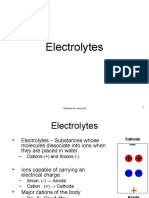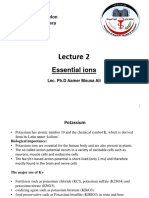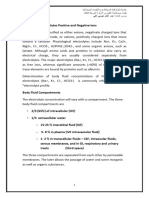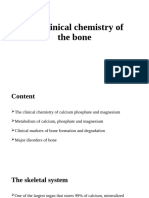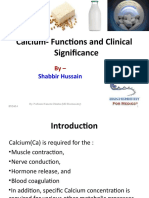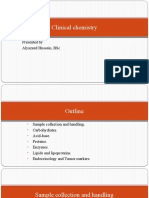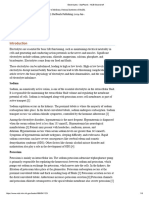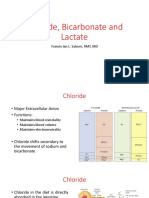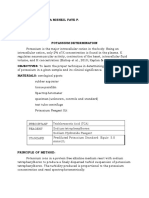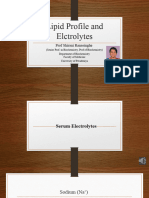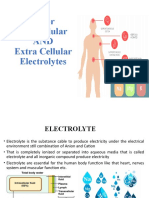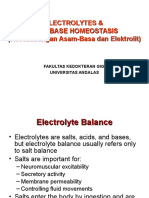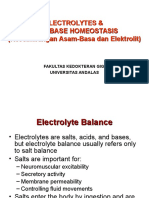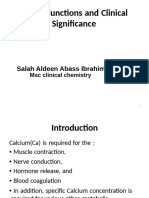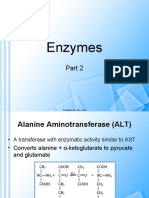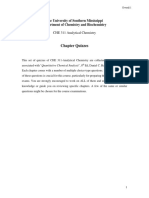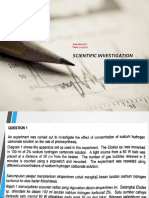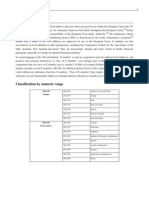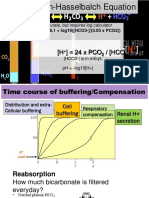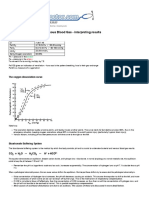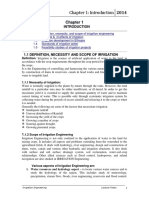0 ratings0% found this document useful (0 votes)
50 viewsElectrolytes: M. Zaharna Clin. Chem. 2009
Electrolytes: M. Zaharna Clin. Chem. 2009
Uploaded by
Ahmed Gaber1) Bicarbonate is the second most abundant anion in extracellular fluid and acts as a transport form for carbon dioxide in plasma. It is regulated by the kidneys and lungs and helps maintain acid-base balance.
2) Magnesium is essential for many enzyme reactions and cardiac and muscle function. It is regulated by dietary intake and kidney excretion. Abnormal levels can cause cardiovascular and neuromuscular issues.
3) Calcium is critical for heart function and bone health. Its levels are tightly controlled by parathyroid hormone, vitamin D, and kidney absorption and excretion. Imbalances can cause disorders.
Copyright:
© All Rights Reserved
Available Formats
Download as PPT, PDF, TXT or read online from Scribd
Electrolytes: M. Zaharna Clin. Chem. 2009
Electrolytes: M. Zaharna Clin. Chem. 2009
Uploaded by
Ahmed Gaber0 ratings0% found this document useful (0 votes)
50 views20 pages1) Bicarbonate is the second most abundant anion in extracellular fluid and acts as a transport form for carbon dioxide in plasma. It is regulated by the kidneys and lungs and helps maintain acid-base balance.
2) Magnesium is essential for many enzyme reactions and cardiac and muscle function. It is regulated by dietary intake and kidney excretion. Abnormal levels can cause cardiovascular and neuromuscular issues.
3) Calcium is critical for heart function and bone health. Its levels are tightly controlled by parathyroid hormone, vitamin D, and kidney absorption and excretion. Imbalances can cause disorders.
Original Title
ELetrolytes--------mazen----2
Copyright
© © All Rights Reserved
Available Formats
PPT, PDF, TXT or read online from Scribd
Share this document
Did you find this document useful?
Is this content inappropriate?
1) Bicarbonate is the second most abundant anion in extracellular fluid and acts as a transport form for carbon dioxide in plasma. It is regulated by the kidneys and lungs and helps maintain acid-base balance.
2) Magnesium is essential for many enzyme reactions and cardiac and muscle function. It is regulated by dietary intake and kidney excretion. Abnormal levels can cause cardiovascular and neuromuscular issues.
3) Calcium is critical for heart function and bone health. Its levels are tightly controlled by parathyroid hormone, vitamin D, and kidney absorption and excretion. Imbalances can cause disorders.
Copyright:
© All Rights Reserved
Available Formats
Download as PPT, PDF, TXT or read online from Scribd
Download as ppt, pdf, or txt
0 ratings0% found this document useful (0 votes)
50 views20 pagesElectrolytes: M. Zaharna Clin. Chem. 2009
Electrolytes: M. Zaharna Clin. Chem. 2009
Uploaded by
Ahmed Gaber1) Bicarbonate is the second most abundant anion in extracellular fluid and acts as a transport form for carbon dioxide in plasma. It is regulated by the kidneys and lungs and helps maintain acid-base balance.
2) Magnesium is essential for many enzyme reactions and cardiac and muscle function. It is regulated by dietary intake and kidney excretion. Abnormal levels can cause cardiovascular and neuromuscular issues.
3) Calcium is critical for heart function and bone health. Its levels are tightly controlled by parathyroid hormone, vitamin D, and kidney absorption and excretion. Imbalances can cause disorders.
Copyright:
© All Rights Reserved
Available Formats
Download as PPT, PDF, TXT or read online from Scribd
Download as ppt, pdf, or txt
You are on page 1of 20
Electrolytes
Part 2
M. Zaharna Clin. Chem. 2009 1
Bicarbonate
• 2nd most abundant anion of ECF.
• The major form of CO2 in plasma
• Major component of the HCO3- /H2CO3
buffering system.
• Serves as a transport form for CO2
produced from metabolic processes in
tissues
M. Zaharna Clin. Chem. 2009 2
Regulation
• Bicarbonate conc. is regulated both in:
– Kidneys through increased or decreased
tubular reabsorption
– And in lungs through exhalation of gaseous
CO2 and H2O
• Decreased levels of HCO3- in plasma
result in acid-base disorder (acidosis)
• Increased levels result in alkalosis
M. Zaharna Clin. Chem. 2009 3
Assay
• Two common methods:
1. Ion selective electrode
2. Enzymatic:
• converts all forms of CO2 to HCO3;
• HCO3 is used to caboxylate
phosphoenolpyruvate.
• Coupled enzyme reaction that measures the
amount of NADH consumed.
• The rate of absorbance change is proportional to
amount of CO2 present.
M. Zaharna Clin. Chem. 2009 4
Anion Gap
• Body water compartments exist in a state of
electroneutrality (anions=cations)
• Routine measurements: Na, K, Cl & HCO3 levels
• Anion Gap is the difference between
unmeasured anions and unmeasured cations.
• Formula: AG=(Na + K)- (Cl + HCO3)
• The "real" balance is given by the equation:
[Na]+ [K] + [other cations] = [Cl] + [HCO3] + [other anions]
([Na]+ [K]) - ([Cl] + [HCO3])= [other anions] - [other cations]
= "Anion Gap“
M. Zaharna Clin. Chem. 2009 5
Anion Gap
• Some of the unmeasured cations (~7Mmol/L)
include calcium, magnesium, and most other
minerals.
• Unmeasured anions (~24 Mmol/L) include
proteins like albumin, and phosphates, sulfates,
etc.
• There are always more unmeasured anions than
cations, and thus the "anion gap" equation is
always greater than zero.
M. Zaharna Clin. Chem. 2009 6
Clinical Uses of the Anion Gap
• To detect the presence of a metabolic acidosis
• Help differentiate between causes of a metabolic
acidosis: high anion gap versus normal anion
gap metabolic acidosis.
• In an inorganic metabolic acidosis (eg due HCl
infusion), the infused Cl- replaces HCO3 and the
anion gap remains normal.
• In an organic acidosis, the lost bicarbonate is
replaced by the acid anion which is not normally
measured.
M. Zaharna Clin. Chem. 2009 7
Magnesium
• 4th most abundant cation in the body and 2nd
most abundant intracellular cation.
• 53 % of Mg found in the bone, 46 % in muscle
and tissue, <1% is present in the serum.
• The Mg circulating in serum is in the bound form
(one third-bound to albumin), of the remaining
two thirds- (61%) is in the free or ionized form, 5
% bound to phosphate and citrate.
• Free form is physiologically active.
M. Zaharna Clin. Chem. 2009 8
Regulation of Magnesium
• Regulated by dietary intake, intestine
may absorb 20-65 % of dietary intake
and body needs.
• Kidneys regulate absorption and
excretion of Mg.
• PTH increases the renal reabsorption of
Mg
M. Zaharna Clin. Chem. 2009 9
Clinical Significance
• Roles in the body:
• Myocardial rhythm and contraction
• Cofactors in enzyme activation
• Regulation of ATPase ion pump
• Abnormal levels related to cardiovascular,
metabolic, and neuromuscular disorders.
M. Zaharna Clin. Chem. 2009 10
Hypo- & Hypermagnesaemia
• Hypomagnesaemia:
1. Reduce intake
2. Decreased absorption
3. Increased excretion
• Hypermagnesaemia caused by:
1. Decreased excretion
2. Increased intake
M. Zaharna Clin. Chem. 2009 11
Assay
• Methods (colormetric)
1. Calmagite
2. Formazan dye
3. Methylthymol blue
M. Zaharna Clin. Chem. 2009 12
Calcium (Ca+2)
• 99 % of calcium is associated with bone tissue
• Only 1 % of body calcium is in the plasma
– 45 % ionized (active form)
– 40 % protein bound
– 15 % bound to other compounds
• Critical component of cardiac function
M. Zaharna Clin. Chem. 2009 13
Regulation
• Decreased plasma ionized Ca stimulates
release of PTH
• PTH increases renal reabsorption of
Calcium
• PTH stimulates Vitamin D activation
• Vitamin D increases GI absorption of
Calcium
M. Zaharna Clin. Chem. 2009 14
Regulation
M. Zaharna Clin. Chem. 2009 15
• Causes of hypocalcemia
– Hypoparathyroidism
– Vitamin D deficiency
• Causes of hypercalcemia
– Hyperparathyroidism
M. Zaharna Clin. Chem. 2009 16
Phosphate
• Element found everywhere, participates in
various biochemical processes.
– Most significant: ATP, Creatine Phosphate,
phosphoenolpyruvate reactions.
– Important compound in the release of O2 from
Hb (2,3-DPG)
• Distribution: two forms
1. Organic
2. Inorganic
M. Zaharna Clin. Chem. 2009 17
Regulation
• Absorbed in the intestine, regulated by renal
excretion or reabsorption.
• Renal regulation is effected by factors such as
Vit. D (↑), acid-base balance and PTH (↓).
M. Zaharna Clin. Chem. 2009 18
Clinical application
• Hypophosphatemia: decreased level of
phosphate in blood
• Hyperphoahatemia: patients with acute
and chronic renal failure are at the
greatest risk for condition.
M. Zaharna Clin. Chem. 2009 19
Assay
• Methods:
• Photometric method:
– the reaction of phosphate ions with molybdate
– form complex structures such as ammonium
phosphomolybdate
– One can measure phosphomolybdate complexes
directly or convert them to molybdenum blue using a
wide variety of reducing agents
• Enzymatic Method
M. Zaharna Clin. Chem. 2009 20
You might also like
- Exercise No. 2 Content Uniformity Test of Sodium Bicarbonate TabletsDocument5 pagesExercise No. 2 Content Uniformity Test of Sodium Bicarbonate TabletsRaisa Louise Gamiao Tattao0% (1)
- Calcium, Phosphate and MagnesiumDocument46 pagesCalcium, Phosphate and Magnesiumkiedd_04100% (4)
- Non-Protein Nitrogen (NPN) CompoundsDocument34 pagesNon-Protein Nitrogen (NPN) CompoundsAhmed GaberNo ratings yet
- Alkalinity Management in Shrimp PondDocument3 pagesAlkalinity Management in Shrimp Pondly minh quan100% (1)
- Chemical Formula Writing WorksheetDocument4 pagesChemical Formula Writing Worksheetprabhu4321100% (3)
- Electrolytes: M. Zaharna Clin. Chem. 2009Document35 pagesElectrolytes: M. Zaharna Clin. Chem. 2009Ahmed GaberNo ratings yet
- Subclinical Metabolic Acidosis Prof Nagy AbdelhadyDocument54 pagesSubclinical Metabolic Acidosis Prof Nagy AbdelhadymonaNo ratings yet
- Essential IonsDocument18 pagesEssential IonsAli HassanNo ratings yet
- Body EssentialselectrolytesDocument21 pagesBody EssentialselectrolytesAli HassanNo ratings yet
- Chapter 2 Electrolytes and Body Fluid AnalysiDocument103 pagesChapter 2 Electrolytes and Body Fluid AnalysiSanyii MamuyeNo ratings yet
- Disorders of Calcium, Inorganic Phosphate and Magnesium Metabolism 1Document62 pagesDisorders of Calcium, Inorganic Phosphate and Magnesium Metabolism 1IiiNo ratings yet
- Renal BiochemistryDocument47 pagesRenal BiochemistryIzzah AtqaNo ratings yet
- The Clinical Chemistry of The BoneDocument46 pagesThe Clinical Chemistry of The BonerexasinganoNo ratings yet
- Potassium For Med StudentsDocument28 pagesPotassium For Med StudentsJoel Topf100% (11)
- Electrolytes & Acid-Base Homeostasis (Keseimbangan Asam-Basa Dan Elektrolit)Document48 pagesElectrolytes & Acid-Base Homeostasis (Keseimbangan Asam-Basa Dan Elektrolit)Andwitya PrameshwariNo ratings yet
- DiureticsDocument15 pagesDiureticsahsaanahmadNo ratings yet
- Acid-Base DisturbancesDocument19 pagesAcid-Base Disturbancesameen.tamma34No ratings yet
- Calcium PPT BSDocument58 pagesCalcium PPT BSMedical NotesNo ratings yet
- Clinical Chemistry: Presented by Alyazeed Hussein, BSCDocument43 pagesClinical Chemistry: Presented by Alyazeed Hussein, BSCMONFOLANo ratings yet
- ElectrolytesDocument8 pagesElectrolytesMuhammad IkramNo ratings yet
- Calcium Functionsandsignificance 140724094015 Phpapp01(1)Document58 pagesCalcium Functionsandsignificance 140724094015 Phpapp01(1)sasa bassNo ratings yet
- Acid Base Disorders YidnekachewDocument51 pagesAcid Base Disorders Yidnekachewሀይደር ዶ.ርNo ratings yet
- Chloride, Bicarbonate and LactateDocument32 pagesChloride, Bicarbonate and LactateElla OrtegaNo ratings yet
- 12 Bicarbonate, Calcium, Phosphate and MagnesiumDocument38 pages12 Bicarbonate, Calcium, Phosphate and MagnesiumFrances FranciscoNo ratings yet
- Acid BaseDocument53 pagesAcid BaseMohammed Ahmed BamashmosNo ratings yet
- ELECTROLYTESDocument7 pagesELECTROLYTESSleepy AssNo ratings yet
- اليزيد ChemistDocument53 pagesاليزيد ChemistRa'aft Al-SamawiNo ratings yet
- Theory 10 - Lipid Profile - Electrolytes Part 2Document71 pagesTheory 10 - Lipid Profile - Electrolytes Part 2Navoda ThathsaraniNo ratings yet
- Calcium BookDocument28 pagesCalcium BookLucius33No ratings yet
- The Renal SYSTEM: Supriya VeerallaDocument53 pagesThe Renal SYSTEM: Supriya VeerallaherbirdNo ratings yet
- 6.0 ElectrolytesDocument4 pages6.0 ElectrolytesHry WkNo ratings yet
- Calcium and Phosphate Metabolism 1Document14 pagesCalcium and Phosphate Metabolism 1samueltoluwabori360No ratings yet
- ELECTROLYTEesDocument12 pagesELECTROLYTEesNatalie JuntadoNo ratings yet
- Jurnal DM 2Document7 pagesJurnal DM 2Elang SudewaNo ratings yet
- Biochemistry of Kidneys and UrineDocument18 pagesBiochemistry of Kidneys and UrineAndrias PutriNo ratings yet
- Serum Electrolytes-Part 1Document22 pagesSerum Electrolytes-Part 1Marwa 2002No ratings yet
- Ah-2019 Keseimbangan Asam Basa-Diskusi Panel Blok 1.6Document16 pagesAh-2019 Keseimbangan Asam Basa-Diskusi Panel Blok 1.6Jamaluddin HaikhahNo ratings yet
- Minerals FinalDocument103 pagesMinerals Finallovi bahunNo ratings yet
- كيمياء سريرية 19Document31 pagesكيمياء سريرية 19Aya AshrafNo ratings yet
- Perioperative Acide-Base Balance - Ahmad DamlajDocument26 pagesPerioperative Acide-Base Balance - Ahmad DamlajpaulaNo ratings yet
- ELECTROLYTESDocument8 pagesELECTROLYTESvarshith gandlaNo ratings yet
- Hypo Kale MiaDocument34 pagesHypo Kale MiaSyafniYuliaSistriNo ratings yet
- Uremic Toxicity: Kopple J. D. and Massry S. D.:Nutritional Management of Renal Disease, p97-190Document34 pagesUremic Toxicity: Kopple J. D. and Massry S. D.:Nutritional Management of Renal Disease, p97-190Muhammad Yusuf Arief AkbarNo ratings yet
- LECTURE 4 - Major Intra - and Extracellular ElectrolytesDocument66 pagesLECTURE 4 - Major Intra - and Extracellular ElectrolytesGamotkoto PharmacyNo ratings yet
- Mineral, PH, Immunological Markers Plus CaseDocument55 pagesMineral, PH, Immunological Markers Plus CaseVio MincuNo ratings yet
- Major IntracelularDocument67 pagesMajor Intracelularfarooq shah shabbirNo ratings yet
- Blood Gases, PH, and Buffer SystemDocument22 pagesBlood Gases, PH, and Buffer SystemAhmed GaberNo ratings yet
- Electrolytes & Acid-Base Homeostasis (Keseimbangan Asam-Basa Dan Elektrolit)Document38 pagesElectrolytes & Acid-Base Homeostasis (Keseimbangan Asam-Basa Dan Elektrolit)hanapfadhilahNo ratings yet
- Hepatic Encephalopathy 2Document45 pagesHepatic Encephalopathy 2Vasanth KrishnanNo ratings yet
- Electrolytes & Acid-Base Homeostasis (Keseimbangan Asam-Basa Dan Elektrolit)Document38 pagesElectrolytes & Acid-Base Homeostasis (Keseimbangan Asam-Basa Dan Elektrolit)hanapfadhilahNo ratings yet
- Distribution of This Potassium Between The Extracellular and Intracellular FluidDocument9 pagesDistribution of This Potassium Between The Extracellular and Intracellular FluidLovelle LopezNo ratings yet
- Minerals C 4Document40 pagesMinerals C 4Jasmine sindhooNo ratings yet
- Renal Tubular AcidosisDocument59 pagesRenal Tubular Acidosiskash_buNo ratings yet
- Chapter 3. Major Intra and Extra Cellular ElectrolytesDocument16 pagesChapter 3. Major Intra and Extra Cellular ElectrolytesNo IdeaNo ratings yet
- ELECTROLYTESDocument37 pagesELECTROLYTESHaki TozakiNo ratings yet
- Poisoning: PWM Olly Indrajani 2014Document45 pagesPoisoning: PWM Olly Indrajani 2014arieska daraNo ratings yet
- Chapter 11 Electrolytes LectureDocument76 pagesChapter 11 Electrolytes Lecturegabo dasNo ratings yet
- Acid BaseDocument14 pagesAcid BaseBrinna Anindita SatriaNo ratings yet
- Urea Cycle and Disorders - RM - F2014Document18 pagesUrea Cycle and Disorders - RM - F2014Leon WarrenNo ratings yet
- Wa0003Document30 pagesWa0003محمد رزاق مزهر جبرNo ratings yet
- SASA calcium importance and clinical significanceDocument46 pagesSASA calcium importance and clinical significancesasa bassNo ratings yet
- Urinary Stones: Medical and Surgical ManagementFrom EverandUrinary Stones: Medical and Surgical ManagementMichael GrassoNo ratings yet
- Equine Fluid TherapyFrom EverandEquine Fluid TherapyC. Langdon FieldingNo ratings yet
- هام جداDocument93 pagesهام جداAhmed GaberNo ratings yet
- امتحان برومتريك ميكروبيولوجي 19-11-2011Document7 pagesامتحان برومتريك ميكروبيولوجي 19-11-2011Ahmed GaberNo ratings yet
- Lipids - & - Lipoproteins - Mazen 2Document31 pagesLipids - & - Lipoproteins - Mazen 2Ahmed GaberNo ratings yet
- نماذج اسئلة الهيئة السعودية للتخصصات الصحية للاخصائيين والاطباء بالمختبراتDocument68 pagesنماذج اسئلة الهيئة السعودية للتخصصات الصحية للاخصائيين والاطباء بالمختبراتAhmed GaberNo ratings yet
- Pancreas Function MazenDocument15 pagesPancreas Function MazenAhmed GaberNo ratings yet
- Enzymes: M. Zaharna Clin. Chem. 2009Document32 pagesEnzymes: M. Zaharna Clin. Chem. 2009Ahmed GaberNo ratings yet
- Overview of Clinical ChemistryDocument30 pagesOverview of Clinical ChemistryAhmed Gaber0% (1)
- Carbohydrates - Part - 1 - MazenDocument35 pagesCarbohydrates - Part - 1 - MazenAhmed GaberNo ratings yet
- Carbohydrates - Part - 2 - MazenDocument28 pagesCarbohydrates - Part - 2 - MazenAhmed GaberNo ratings yet
- Blood Gases Mazen 2Document16 pagesBlood Gases Mazen 2Ahmed GaberNo ratings yet
- 1 - MCQs Classified اسئله د محمد امامDocument68 pages1 - MCQs Classified اسئله د محمد امامAhmed GaberNo ratings yet
- Blood Gases, PH, and Buffer SystemDocument22 pagesBlood Gases, PH, and Buffer SystemAhmed GaberNo ratings yet
- CHE311 Analytical Chemistry Quizzes CollectionDocument161 pagesCHE311 Analytical Chemistry Quizzes CollectionRenee KimNo ratings yet
- Scienctific Investigation (Factors Affecting The Rate of Photosynthesis)Document14 pagesScienctific Investigation (Factors Affecting The Rate of Photosynthesis)WONG AI WAN MoeNo ratings yet
- Pit Chem LecDocument5 pagesPit Chem LecIsha Nathalie GalimbaNo ratings yet
- i-STAT Alinity V: Utilization GuideDocument8 pagesi-STAT Alinity V: Utilization GuideTony ChenNo ratings yet
- E NumberDocument23 pagesE NumberMahar Nadeem QasimNo ratings yet
- Experiment No. 9Document3 pagesExperiment No. 9Sanket AwareNo ratings yet
- DetoxificationDocument80 pagesDetoxificationGabriel100% (1)
- Aqua SILENCERDocument28 pagesAqua SILENCERAnandu Pm100% (5)
- Lista e UriDocument25 pagesLista e UriGgy VictorNo ratings yet
- Assessment of Water Quality of First Flush Roof RunoffDocument12 pagesAssessment of Water Quality of First Flush Roof RunoffChristoper ChandraNo ratings yet
- Acid Base Balance DR Ahmad Mowafy Revision UpdatedDocument18 pagesAcid Base Balance DR Ahmad Mowafy Revision UpdatedRaouf Ra'fat SolimanNo ratings yet
- Reminéralisation Eau DessalDocument17 pagesReminéralisation Eau DessalHouria Azizi AlaouiNo ratings yet
- Tutorial ChemistDocument27 pagesTutorial Chemisthujanku5915No ratings yet
- Cavaliere 2016Document3 pagesCavaliere 2016Huệ MinhNo ratings yet
- Acid Base Balance OR OR Regulation of Blood PHDocument175 pagesAcid Base Balance OR OR Regulation of Blood PHhirendra patel100% (1)
- Sodium Bicarbonate - BP2022Document3 pagesSodium Bicarbonate - BP2022angela.evansNo ratings yet
- 2018-2017 لوا سروك -2-ةمزلم Volumetric analysis (titration analysis) :- عوضوم 30 ةحفص عباتDocument26 pages2018-2017 لوا سروك -2-ةمزلم Volumetric analysis (titration analysis) :- عوضوم 30 ةحفص عباتناروتو كيمر- N4Ruto-GamerNo ratings yet
- Acid Base WorkshopDocument71 pagesAcid Base WorkshopLSU Nephrology Transplant Dialysis AccessNo ratings yet
- Importance of BuffersDocument7 pagesImportance of BuffersAsad AzizNo ratings yet
- BP2011 IndexDocument66 pagesBP2011 IndexMahesh_ChokshiNo ratings yet
- Baking Powder Dan VinegarDocument2 pagesBaking Powder Dan VinegarSyakur Hakim PauziNo ratings yet
- ABG & VBG - Arterial and Venous Blood Gas - Interpreting ResultsDocument6 pagesABG & VBG - Arterial and Venous Blood Gas - Interpreting ResultsmmmmzNo ratings yet
- Chapter 1 - IntroductionDocument24 pagesChapter 1 - IntroductionReffisa Jiru100% (1)
- Design, Qualification, and Validation of Water Systems: July 2018Document15 pagesDesign, Qualification, and Validation of Water Systems: July 2018miftahul jannahNo ratings yet
- Liquid Chromatography of Ions CL BR ISO-10304-1-1992Document11 pagesLiquid Chromatography of Ions CL BR ISO-10304-1-1992maría joséNo ratings yet
- Conservation of Underwater Archaeological Finds ManualDocument95 pagesConservation of Underwater Archaeological Finds Manualfred2000leviNo ratings yet
- Blood Gas InterpretationDocument28 pagesBlood Gas InterpretationgjdbfiuvaNo ratings yet






